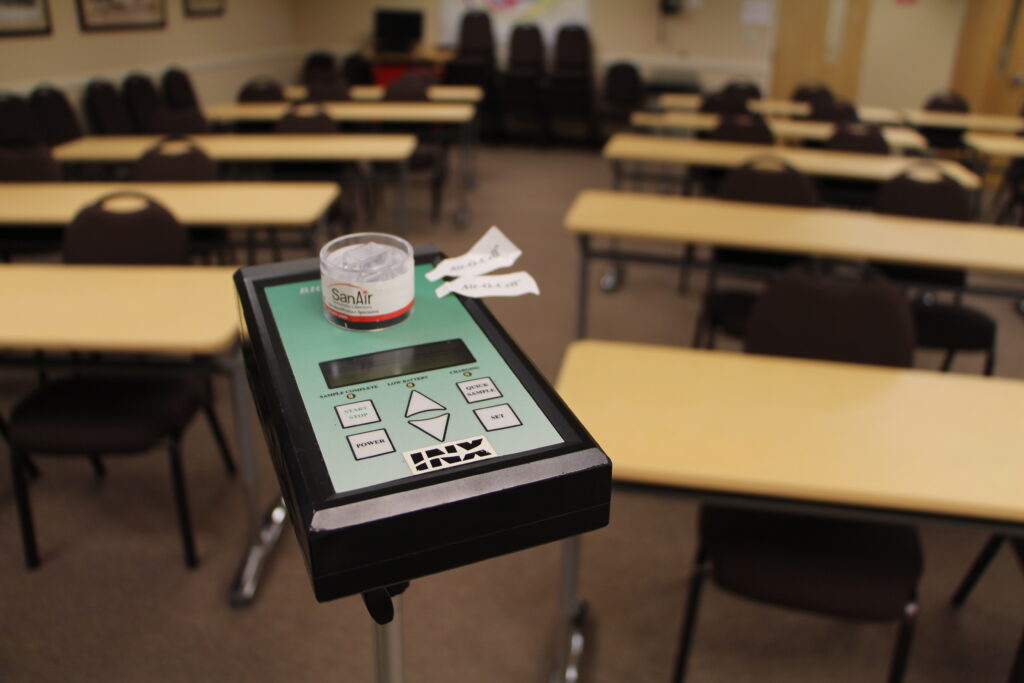Whether you’re a business owner or an employee, no one wants to find mold in their office. Not only does mold impact office air quality, but It also smells bad, looks unpleasant, and can cause a number of other problems that can affect everyone who works in the office.
Everyone needs clean, healthy air to breathe, and compromised air quality can make any office a less-than-ideal place to work. So, just how does mold impact office air quality?
Well, it’s no secret that mold spores negatively impact the air quality in any indoor environment, whether it’s an office setting or not. Because of this, it’s essential that office managers and business owners be vigilant when it comes to potential mold growth. So, what causes mold to grow in an office in the first place, how can it affect your business, and what can you do about it?
What Causes Mold in an Office Setting?
The causes of mold in an office are no different than the causes of mold in any other building. Mold doesn’t discriminate and as long as there is excess moisture and a surface for it to grow on, it will do exactly that. Whether it’s a poorly ventilated bathroom, a damp office kitchen, or water intrusion through the office roof or foundation, all of these are common issues that can cause mold growth in an office setting.
How Mold Can Affect Your Business
Mold isn’t just a simple workplace inconvenience. In fact, besides the property damage that it can cause, mold spores in the air can have a significant effect on every worker in the office. So, if you have an office mold problem, here are just a few of the ways that mold can negatively affect your business.
Mold Health Effects in the Workplace and Sick Days
Mold exposure can cause a number of health problems that only get worse the longer someone is exposed. From skin and eye irritation to respiratory issues like asthma, these problems will become increasingly common for anyone who spends time in the office, leading to an increase in the number of sick days that workers may need to take to recover from all that bad air.
Reduced Productivity
An office is supposed to promote productivity and make it easy for employees to focus and work at peak efficiency. However, if your office is full of mold, it definitely won’t live up to these expectations. Whether a worker calls in sick or not, sick employees simply aren’t as productive as happy and healthy ones, making office mold problems and reduced productivity something that goes hand in hand.

Common Signs of Mold Growth
The best way to keep a mold problem from slowing down your office is to catch the problem early. But, in order to do this, you need to know what to look for. So, if you’re trying to be more vigilant about preventing office mold growth, here’s what you should look out for.
Musty, Rotten Smells
Often the first sign of mold growth is an unpleasant, musty, or rotten smell coming from the affected area. It may not completely fill the office at first, but if you or any of your employees smell something odd coming from an area that has problems with excess moisture or humidity, it’s likely the mold is to blame.
Watermarks, Discoloration, Fuzz, and Slime
If you don’t catch mold growth in its earliest stages, it will start to present some obvious visual signs that are easy to point out. Watermarks, discoloration, and fuzzy or slimy spots on surfaces like drywall and ceiling tiles, that continue to grow over time are all telltale signs that mold has taken root and is thriving in your office.

Improving Office Air Quality and Keeping Your Office Mold-Free
Whether your office has a history of mold issues or not, there are plenty of ways that you can improve your office’s air quality and stay on top of any potential mold problems before they start. From simple mold testing and air quality monitors to utilizing dehumidifiers, cleaning ducts, and increasing ventilation, here is everything you need to know about how to keep your office mold-free no matter what.
Mold Testing
One of the best ways to ensure that your office stays mold-free is to conduct regular mold testing. Mold tests can detect even the smallest quantities of mold spores in an indoor environment, making it easy to detect mold growth before it gets out of hand and starts causing problems.
Indoor Air Quality Monitors and Other Preventative Measures
Another great way to address potential mold and air quality-related issues is to use an air quality detector. These detectors don’t specifically detect mold, but they do monitor the humidity, particulate matter, and volatile organic compounds (VOCs) present in the air, all of which can be potential causes or signs of mold.
For example, if you install one of these monitors and it consistently records high levels of humidity in the office, this is a big sign that your office may be the ideal place for mold to start growing, and you should buy dehumidifiers to address the problem.
On the other hand, if the monitor detects high levels of particulate matter and VOCs, this could be a sign that mold is already present, and you may need to hire a company to remove the mold and/or clean your ductwork.

Contact INX Indoor Air Quality Today
Does your office have air quality or mold issues? Give INX Indoor Air Quality a call. Their team of indoor air quality and mold remediation experts is well-equipped to address your problems quickly and ensure that your office remains an ideal place for you and your employees to work. So, don’t let mold negatively affect the air quality in your office. Call INX Indoor Air Quality and take the first step toward a mold-free office today!



